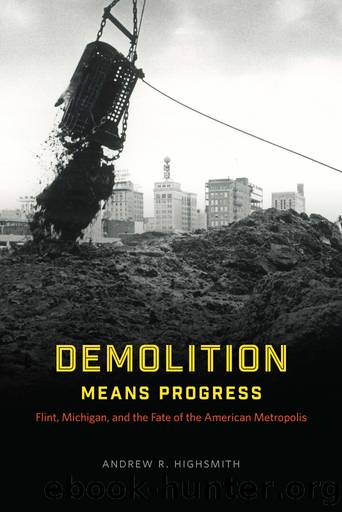Demolition Means Progress by Andrew R. Highsmith

Author:Andrew R. Highsmith [Highsmith, Andrew R.]
Language: eng
Format: epub
ISBN: 9780226251080
Publisher: The University of Chicago Press
Published: 2015-06-04T00:00:00+00:00
Figure 8.1. An abandoned Section 235 home in Beecher, 2012. Local builders erected this home in Beecher during the early 1970s as part of the Section 235 low-income housing program. Critics of the initiative argued that it exploited poor people and led to racial segregation, social conflict, and property abandonment. Photograph by Andrew R. Highsmith, 2012.
A 1974 survey of affordable housing sponsored by the Genesee County Metropolitan Planning Commission painted an even bleaker picture of the Section 235 program. According to this report, 91 percent of the Section 235 borrowers in Genesee County complained of problems with their homes. In spite of the complaints, however, auditors found that builders had repaired the homes of only 19 percent of the owners surveyed. Forced to absorb the repair costs themselves, many owners of Section 235 units succumbed to bankruptcy and lost their homes to foreclosure during the global economic contractions of the 1970s.53 Between 1969 and 1973, foreclosure rates in the county increased by 184 percent, due in large part to the rash of mortgage defaults from Section 235 homeowners. By March 1974 more than one in four of the Section 235 homeowners in Genesee County had ceased making payments on their homes.54 Because the HUD Act required the federal government to pay off the balance of the loan in all Section 235 foreclosure cases, local bankers and holders of mortgage-backed securities continued to profit financially even when homeowners defaulted on their payments. Consequently, investors remained supportive of the 235 initiative even in the face of the growing foreclosure crisis. As evidence of this fact, in March 1970, despite mounting criticism of the program, Howard L. Gay, a senior vice president of the Citizens Commercial and Savings Bank in Flint, wrote a letter to Congressman Riegle urging him to vote for the maximum appropriation for the 235 initiative, avowing, âThis program is successful.â55
On their own, the numerous reports documenting the shoddy construction and geographic concentration of the Section 235 units would have been sufficient to mar the image of the HUD Act. However, buried deep within many of these documents were charges of profiteering and usury that threatened to delegitimize the entire foundation of HUDâs affordable housing program. The root of the problem was the governmentâs laissez-faire approach to regulation. In their quest to âcut the red tape to pink ribbons,â Gulledge and other federal administrators eviscerated the regulatory structures that might have protected individual citizens and local communities from unscrupulous developers.56 Businesses participating in the Section 235 program thus committed acts of economic exploitation without fear of punishment.57 Builders, of course, routinely cut corners in order to turn a profit. But the fleecing of poor buyers occurred at virtually every stage of the process. One of the most common schemes involved a practice known as âflipping,â in which investors acquired ramshackle properties, completed only minor cosmetic repairs, and then resold them at inflated costs to unsuspecting 235 buyers. Fueling this process were legions of dishonest appraisers who were willing to approve thousands of substandard units for sale in exchange for a steady stream of new customers.
Download
This site does not store any files on its server. We only index and link to content provided by other sites. Please contact the content providers to delete copyright contents if any and email us, we'll remove relevant links or contents immediately.
International Integration of the Brazilian Economy by Elias C. Grivoyannis(90727)
The Radium Girls by Kate Moore(11921)
Turbulence by E. J. Noyes(7935)
Nudge - Improving Decisions about Health, Wealth, and Happiness by Thaler Sunstein(7615)
The Black Swan by Nassim Nicholas Taleb(7010)
Rich Dad Poor Dad by Robert T. Kiyosaki(6399)
Pioneering Portfolio Management by David F. Swensen(6226)
Man-made Catastrophes and Risk Information Concealment by Dmitry Chernov & Didier Sornette(5921)
Zero to One by Peter Thiel(5684)
Secrecy World by Jake Bernstein(4643)
Millionaire: The Philanderer, Gambler, and Duelist Who Invented Modern Finance by Janet Gleeson(4374)
The Age of Surveillance Capitalism by Shoshana Zuboff(4209)
Skin in the Game by Nassim Nicholas Taleb(4161)
Bullshit Jobs by David Graeber(4094)
The Money Culture by Michael Lewis(4074)
Skin in the Game: Hidden Asymmetries in Daily Life by Nassim Nicholas Taleb(3929)
The Dhandho Investor by Mohnish Pabrai(3698)
The Wisdom of Finance by Mihir Desai(3650)
Blockchain Basics by Daniel Drescher(3495)
